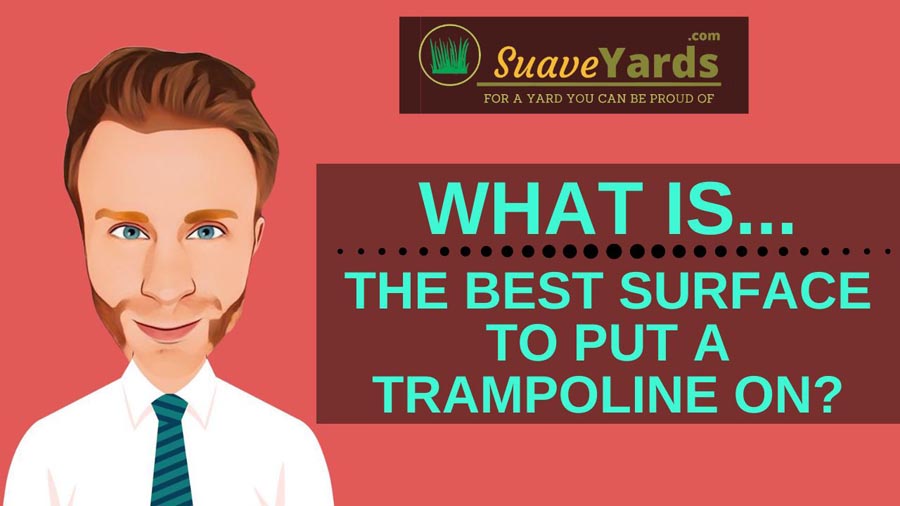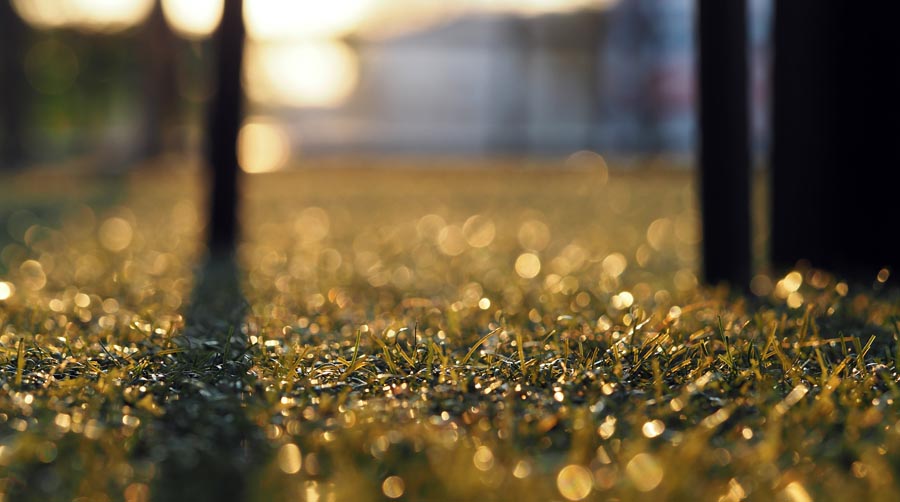
When it comes to installing a trampoline in your yard, there are a number of potential surfaces it could go on.
And each has its own plusses and minuses.
So in this article we are going to look at every option and rank them from best to worst (in our opinion).
So what is the best surface to put a trampoline on?
Let’s find out…
What Is The Best Surface To Put A Trampoline On?
Taking cost, safety and ease of installation into account, grass is the best surface to put a trampoline on. However, if you don’t mind a slightly more complicated installation process and spending a bit more money then artificial grass, rubber mulch and sinking the trampoline into the ground are also excellent options. You should avoid situating a trampoline on decking or concrete however.
As we discussed when we look at whether you can put a trampoline on a slope, the most important thing when installing a trampoline is to ensure it is on a flat, stable surface.
It needs to be a surface that will provide adequate support, and will stop the trampoline from shifting from side to side and up and done.
And it should also not be too hard, should someone unfortunately fall off the trampoline.
Also of course you have to take installation cost and complexity into account as well.
#1: Grass
In terms of aesthetics, cost, ease of installation and safety, grass is our favored surface for putting a trampoline on.
Grass looks natural, it doesn’t incur any additional cost for installation, and it is simply a case of finding the optimum spot for your trampoline and then anchoring it in safely.
It also provides a decent amount of cushioning should someone fall off of the trampoline, although there are other options on this list that are even safer in that respect.
The downsides are that, depending upon your soil type, the legs could sink into the ground, and that the grass below the trampoline could be killed off as it is starved of sunlight and moisture.
Or in some instances, mainly in warmer climates, the grass below the trampoline could grow thicker and lusher.
This is something we covered in our post asking if trampolines kill grass.
Either way, there is no surface more convenient for a trampoline than grass.
- Pros: Cheap, convenient, easy installation, reasonable shock absorption.
- Cons: Grass may die underneath the trampoline.
#2: Artificial Grass

There are a whole host of other surfaces that provide a good surface for a trampoline and right up there beneath its natural sibling is artificial grass.
And it has its benefits over grass, namely that it takes no maintenance and it eliminates the problem of grass underneath the trampoline dying.
It also looks good and provides around the same level of cushioning as natural grass.
The downsides are that it is a more expensive and more time-consuming option than putting it on natural grass.
According to the Install Artificial website, the cost of having artificial grass installed in your yard can be anything from $9.2 per sq. ft to $14.7 per sq. ft depending upon the size of the area that needs to be covered.
- Pros: No maintenance, looks good, easy to install, reasonable shock absorption.
- Cons: Moderate price
#3: Rubber Mulch
Number three on our list of the best surfaces to put a trampoline on is rubber mulch.
In terms of safety, rubber mulch is possibly the best material out there as it provides fantastic shock resistance.
It is also resistant to mold and won’t rot, so will last you a long time.
You can probably see now why lots of play areas use rubber mulch as a base beneath their equipment.
Installation is more time-consuming and costly than grass or artificial grass however.
To cover a 15ft by 15ft area, you would need somewhere in the region of 1,500 lbs of rubber mulch, which is likely to set you back around $500 to $750.
Then there is the installation on top of that.
Also the fact it is not biodegradable also has its downsides, over time you could easily find pieces of it making their way into your house or flower beds!
- Pros: Great shock absorption, will last a long time,
- Cons: More expensive, more complex installation.
#4: Sink It Into the Ground
In terms of its look and safety, having a trampoline sunken into the ground is hard to beat.
Unfortunately, it is also probably the most expensive and complicated option on this list.
It is something that will need to be undertaken by a professional, but with the trampoline at ground level it can barely be seen, and if anyone falls off it the chances of them suffering a serious injury are severely reduced.
Obviously once the trampoline is in place, it is there for the lifetime of your garden, unless you fancy refilling a big trampoline-shaped hole sometime in the future.
- Pros: Looks great, very safe.
- Cons: Very expensive.
#5: Wood Chips
Wood chips are a similar option to rubber mulch, only at a cheaper cost.
Whereas rubber mulch can cost anything from $9 to $15 per cubic foot, natural wood mulch costs around $3 to $4 per cubic foot.
It might not provide quite the same amount of shock absorption as rubber mulch, but it is still softer than grass. It looks good too.
The downside is it attracts bugs and pests and can be a breeding ground for mold and bacteria.
Like rubber mulch it can accidentally be transported indoors too.
- Pros: Cheap, good shock absorption
- Cons: Attract bugs and pests, along with mold and bacteria.
#6: Pea Gravel
Unlike wood chips, pea gravel doesn’t attract bugs and pests. It also drains well, so mold and bacteria are less of a problem too.
It is more expensive however than wood chips, although cheaper than rubber mulch.
Its shock absorption properties are also probably less effective than wood chips, although it does provide a reasonable amount of cushioning.
It is also even worse than wood chips and rubber mulch for getting into clothing (and even young children’s mouths!) and ending up indoors.
- Pros: Clean, reasonably priced.
- Cons: Danger to young children, can get everywhere.
#7: Sand

In terms of its shock absorption properties, sand is actually pretty good and probably better than grass, which is top of our list.
It is also pretty easy to install.
For me the main problem is how easily it gets tracked indoors, and also the fact that any animals in the vicinity will likely use it as a toilet.
And combine this with lots of young children playing around it, and it is a recipe for disaster.
It is also fairly expensive, comparable in price to rubber mulch.
- Pros: Good shock absorption, easy to install.
- Cons: Expensive, a health hazard.
#8: Decking
The problem with putting a trampoline on decking is whether the decking itself is strong enough to withhold it.
Most decks are built from pressure-treated lumber, and it is unlikely they will be able to bear the continual weight of children jumping up and down on a trampoline placed on the decking.
Every time your children are out there jumping on the trampoline they are most likely weakening the decking.
Obviously, this could have potentially disastrous consequences in the long term.
A further problem is ensuring the trampoline is securely fastened down so it doesn’t move around. This is much tougher on decking than most other surfaces.
- Pros: A flat surface
- Cons: Dangerous
#9: Concrete
Right at the bottom of our list, the least favored surface to put a trampoline on is concrete.
This is because of the damage it can do to you and your trampoline.
The trampoline frame and legs will be damaged from the continual impact on the hard ground.
The trampoline is likely to move around too as you won’t be able to anchor it to the ground because of the concrete.
More importantly, sometimes even the presence of a safety net won’t prevent you from coming off of the trampoline and onto the surface below.
If this surface is concrete, you are risking very serious injury and your trampoline also will not last very long.
- Pros: Flat
- Cons: Damage to you and the trampoline
Final Thoughts

Every potential surface has its pros and cons when it comes to installing a trampoline, but overall some are definitely a lot better than others.
If we were breaking this down into tiers I would put grass, artificial grass, rubber mulch and sinking it into the ground in the top tier as optimum surfaces for your trampoline, wood chips, pea gravel and sand in the middle bracket as adequate surfaces, and decking and concrete at the bottom as surfaces to be avoided.
Grass is the best choice overall in my opinion for its convenience, ease of installation, shock absorption and price.
However if you don’t mind spending a little more then artificial grass, rubber mulch and sinking it directly into the ground are all good options.
Trampolines are potentially hazardous bits of play equipment, but if you plan carefully and take suitable precautions you can make them much safer to use.
Good luck.
